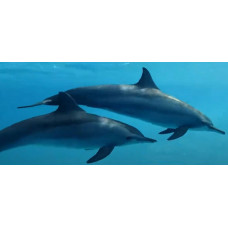Latin name
Stenella longirostris
Other names
Long-snouted dolphin
Identification
The main characteristic is a long, curved snout. Spinner dolphins have different body shapes depending on where they live. They are usually small and slender with a relatively long, thin beak. In the open waters of the eastern Pacific, dolphins have relatively small skulls with short rostrums. Dwarf dolphins are found in Southeast Asia.
Features of fish fins
Adult males have a curved to triangular dorsal fin and a small to medium convex ventral keel. In a few subspecies, some males may have forward tilted vertical fins. In some dolphin populations in the eastern Pacific, the dorsal fins are backwards and males may have dorsal humps and upwardly curved caudal fins.
Fish colouring
They have a tripartite colouration consisting of a dark grey dorsal ridge, a lighter grey lateral border and a white or very pale ventral border. A dark band runs from the eye to the fin, bordered at the top by a thin line. In dolphins, the contrast of the promontory with the lateral field and the smooth curvature of the ventral margin of the promontory above the eye are clearly visible. The ventral white margin extends differentially dorsally almost to eye level; margins are mottled; genital and axillary areas merge. They also have a high to medium contrast between the fin band and the goiter region, where various spots are visible. Fins are dark or mottled.
Distribution
Found in predominantly warm and temperate marine waters around the world. Their habitat includes the North and South Atlantic, the Pacific Ocean, the Indian Ocean and the Mediterranean Sea. They prefer open waters where they can swim freely and hunt their prey.
Habitat
Pelagic oceanodromous species, depth range 0 to 4330 m. Live in family groups, but also have relationships with other individuals outside their groups. Most live in deep waters off islands, other populations are more common along the coast. During the day, island-associated dolphin populations take refuge in coastal waters, then return to specific areas to socialise, rest and rear their calves.
Size
Adults typically reach a length of 129-235 cm and a weight of 23-79 kg.
Behavior
They live in large schools of dozens or even hundreds of individuals. They show great coordination when swimming and hunting. They communicate with each other using a variety of sounds and whistles that can be transmitted over long distances. They migrate in different parts of their range. Some populations migrate between the tropics, following seasonal changes in water temperature and food availability. They may move towards the equator in winter and return to their northern or southern limits in summer. These migrations allow the dolphins to find optimal living conditions and forage for themselves.
Food and feeding habits
Carnivores that feed on various species of fish and squid. The main food items of these dolphins are various species of small and medium-sized herring, as well as some species of cuttlefish and other marine invertebrates. They use echolocation to locate and hunt their prey, and their teeth to capture and crush them before swallowing.
Reproduction
Mothers and cubs form strong social bonds. Sexual maturity is reached between 4 and 7 years (females, 165-170 cm) and between 7 and 10 years (males, 160-180 cm). Indiscriminate, with conspicuous courtship display. The gestation period averages 10 months and only one cub is born. Cubs are born at 3-year intervals, suckled for at least a year and weaned at 1 to 3 years. Breeding is seasonal. Spinner dolphins live for about 20-25 years.
Fishing
Commercially important. These dolphins are also caught for use as shark bait.
Relationship with a person
Safe. They can approach ships and perform a variety of tricks such as somersaults, jumping over waves and demonstrating their ability to handle people.
| Classification | |
| Phylum | Chordata |
| Class | Mammalia |
| Squad | Artiodactyla |
| Family | Delphinidae |
| Genus | Stenella |
| Species | S. longirostris |
| Features | |
| Conservation status | Least Concern |
| Habitat | Pelagic |
| Life span, years | 25 |
| Maximum body weight, kg | 79 |
| Maximum length, cm | 235 |
| Sailing speed, m/s | No information |
| Threat to people | No information |
| Way of eating | Predator |
Spinner dolphin
Tags: spinner dolphin



